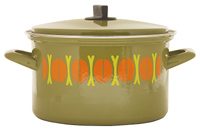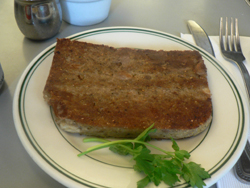|
2009, the last year of the first decade of the new millennium. This New Year
will, in my opinion, bring some major shifts in the culinary universe. Due to
the economy, high-end restaurants that are little more than exercises in
culinary narcissism are going to disappear like donuts in Rosie O’Donnell’s
dressing room. The country is getting back to basics, and so will the food
service industry. Portion sizes are going to get back to normal as chefs and
restaurant owners struggle to stay profitable. I also believe the food itself
will become more simplified. Simple does not mean mediocre. What it does mean
is that weird ingredients for shock value will be gone as consumers focus on
 perceived value. Is the five-dollar-a-cup gourmet coffee necessary when the buck-and-a-half cup is also very good? Consumers are going to be less likely to take
risks on dining out and look for a comfort level with their meal choices. That
means comfort foods will once again rule. perceived value. Is the five-dollar-a-cup gourmet coffee necessary when the buck-and-a-half cup is also very good? Consumers are going to be less likely to take
risks on dining out and look for a comfort level with their meal choices. That
means comfort foods will once again rule.
This is good for chefs also because it will force them to focus on flavor and
technique.
I also foresee a trend where
people will realize that it can be more affordable to cook at home. The
crock-pot, yes, that relic of the 70s, has already started to reemerge. The
crock-pot is braising for dummies. Braising and stewing are cooking
techniques
 that
take tough but flavorful cuts of meat and, through slow cooking with added
moisture, break down the connective tissue. The end result yields a tender
flavorful product. The extra bonus is these cuts are usually less expensive.
These dishes are often considered peasant or poor people’s food. I will let you
in on a little chef’s secret – the peasants eat more flavorful food. I would
rather have a good beef or chicken stew than a filet mignon or poached chicken. that
take tough but flavorful cuts of meat and, through slow cooking with added
moisture, break down the connective tissue. The end result yields a tender
flavorful product. The extra bonus is these cuts are usually less expensive.
These dishes are often considered peasant or poor people’s food. I will let you
in on a little chef’s secret – the peasants eat more flavorful food. I would
rather have a good beef or chicken stew than a filet mignon or poached chicken.
Two of the most flavorful American
regional cuisines are Cajun and Amish. Both cuisines borrowed heavily from their
French and Germanic roots, but adapted the recipes to local ingredients and
indigenous culture. The poor are usually more willing to adapt than the wealthy
and the world of cuisine is richer because of this fact. Frugal is the w ord I
use to describe this style of cooking. Frugal is a very misunderstood word. Most
people think it means cheap. Frugal: Practicing or marked
by economy; as in the expenditure of money or the use of material resources.
Growing up with a Scottish grandfather, it was a term I heard early and often. In terms of cooking I prefer to focus on the second part of the definition.
Economical use of material resources. Being an Agrarian based society, the
Amish excel in this and there is no better example than scrapple. The name says
it all. Made from what’s left after making sausage the scraps are mixed with
cornmeal and cooked. The great American novelist James Michener gives an
excellent description of scrapple and other Amish delights in his book The
Novel. ord I
use to describe this style of cooking. Frugal is a very misunderstood word. Most
people think it means cheap. Frugal: Practicing or marked
by economy; as in the expenditure of money or the use of material resources.
Growing up with a Scottish grandfather, it was a term I heard early and often. In terms of cooking I prefer to focus on the second part of the definition.
Economical use of material resources. Being an Agrarian based society, the
Amish excel in this and there is no better example than scrapple. The name says
it all. Made from what’s left after making sausage the scraps are mixed with
cornmeal and cooked. The great American novelist James Michener gives an
excellent description of scrapple and other Amish delights in his book The
Novel.
 As a nation we are facing times where we may need to become more
economical with our resources. Rather than eat fast food or cheap frozen meals,
if you cook from scratch, you can stretch your resources. If you serve a roast
chicken, don’t throw out the carcass, but put it in the soup pot and with a few
vegetables and maybe some pasta you now have a second and even more flavorful
meal. Buy a bone-in ham and turn the leftovers into bean or split pea soup. Save your empty soup cans and you can make delicious and inexpensive Boston
Brown Bread. Try these dishes and you will find that the peasants really ate
like kings. Until next month, Bon Appétit. As a nation we are facing times where we may need to become more
economical with our resources. Rather than eat fast food or cheap frozen meals,
if you cook from scratch, you can stretch your resources. If you serve a roast
chicken, don’t throw out the carcass, but put it in the soup pot and with a few
vegetables and maybe some pasta you now have a second and even more flavorful
meal. Buy a bone-in ham and turn the leftovers into bean or split pea soup. Save your empty soup cans and you can make delicious and inexpensive Boston
Brown Bread. Try these dishes and you will find that the peasants really ate
like kings. Until next month, Bon Appétit.
Lancaster County Wet Bottom Shoo-fly Pie
-
1 9-inch pie shell, unbaked
- Pre-heat oven to 325 degrees
Crumb topping
- 1 cup flour
- ½ cup light brown sugar
- ¼ cup shortening
- ½ teaspoon salt
Liquid bottom
- 1 cup boiling water
- 1 cup molasses
- 1 teaspoon baking soda
- 1 egg beaten
Mix crumb topping ingredients together until fine. Set
aside. Mix water, molasses and baking soda together. Whisk until foamy. Beat in
egg. Pour into pie shell using large spoon. Mix the crumb mixture into filling.
Bake at 325 degrees for 30-40 minutes.
Boston Brown Bread
- 1 cup rye meal
- ¾ tablespoon baking soda
- 1 cup cornmeal
- 1 teaspoon salt
- 1 cup whole wheat flour
- 1¾ cup milk
- ¾ cup molasses
- 6 empty soup cans
Sift dry ingredients in bowl. Add milk and molasses. Grease
soup cans. Fill two-thirds of the can with batter. Grease foil wrap and tie foil
around cans. Place in sauce pan. Fill with water. Cover. Steam for 3½ hours.
New England Clam Chowder
-
1
dozen quahogs, scrubbed and rinsed
- 8 ounces salt pork, diced
- 1½ cups onions, diced
- 1 cup celery, diced
- 4 potatoes, peeled and diced
- 3 tablespoons butter
- 1 cup flour, as necessary
- Fresh thyme, chopped
- 3 cups milk
- 4 cups clam broth
- Cream, as desired
Place clams in large pot. Cover with cold water. Simmer
until clams open. Remove. Strain liquid reserve. Cool and chop clams.
Render salt pork. Remove. Add onions and celery. Sauté
until softened. Dust with flour to form roux. Cook 2-3 minutes. Add clam broth
and warm milk. Whisk to avoid lumping. Add thyme, potatoes, clam meat and salt
pork. Simmer until potatoes are cooked. Finish with cream, salt and pepper.
Chicken and Dumplings
- 1 chicken cut in eighths
- Seasoned flour
- 2 onions ½ julienned
- 6 ribs celery, bias cut
- 4 carrots, bias cut
- Butter
- Chopped parsley
- Chopped thyme, rosemary
- 3 quarts of chicken stock
In Dutch oven, flour and brown chicken in butter. Remove.
Sweat veggies. Add more butter if necessary. Add chicken. Add rosemary, thyme,
salt and pepper. Add stock. Simmer until chicken is tender. Drop in dumpling
mix. Cook ten minutes uncovered. Serve.
Dumplings
- 4 cups flour
- 6 teaspoons baking powder
- 2 teaspoons salt
- Chopped parsley
- ½ cup shortening
- ½ cup milk
Sift dry ingredients. Cut in shortening. Add milk and
parsley. Cook as above. |

 perceived value. Is the five-dollar-a-cup gourmet coffee necessary when the buck-and-a-half cup is also very good? Consumers are going to be less likely to take
risks on dining out and look for a comfort level with their meal choices. That
means comfort foods will once again rule.
perceived value. Is the five-dollar-a-cup gourmet coffee necessary when the buck-and-a-half cup is also very good? Consumers are going to be less likely to take
risks on dining out and look for a comfort level with their meal choices. That
means comfort foods will once again rule. that
take tough but flavorful cuts of meat and, through slow cooking with added
moisture, break down the connective tissue. The end result yields a tender
flavorful product. The extra bonus is these cuts are usually less expensive.
These dishes are often considered peasant or poor people’s food. I will let you
in on a little chef’s secret – the peasants eat more flavorful food. I would
rather have a good beef or chicken stew than a filet mignon or poached chicken.
that
take tough but flavorful cuts of meat and, through slow cooking with added
moisture, break down the connective tissue. The end result yields a tender
flavorful product. The extra bonus is these cuts are usually less expensive.
These dishes are often considered peasant or poor people’s food. I will let you
in on a little chef’s secret – the peasants eat more flavorful food. I would
rather have a good beef or chicken stew than a filet mignon or poached chicken. ord I
use to describe this style of cooking. Frugal is a very misunderstood word. Most
people think it means cheap. Frugal: Practicing or marked
by economy; as in the expenditure of money or the use of material resources.
Growing up with a Scottish grandfather, it was a term I heard early and often. In terms of cooking I prefer to focus on the second part of the definition.
Economical use of material resources. Being an Agrarian based society, the
Amish excel in this and there is no better example than scrapple. The name says
it all. Made from what’s left after making sausage the scraps are mixed with
cornmeal and cooked. The great American novelist James Michener gives an
excellent description of scrapple and other Amish delights in his book The
Novel.
ord I
use to describe this style of cooking. Frugal is a very misunderstood word. Most
people think it means cheap. Frugal: Practicing or marked
by economy; as in the expenditure of money or the use of material resources.
Growing up with a Scottish grandfather, it was a term I heard early and often. In terms of cooking I prefer to focus on the second part of the definition.
Economical use of material resources. Being an Agrarian based society, the
Amish excel in this and there is no better example than scrapple. The name says
it all. Made from what’s left after making sausage the scraps are mixed with
cornmeal and cooked. The great American novelist James Michener gives an
excellent description of scrapple and other Amish delights in his book The
Novel.  As a nation we are facing times where we may need to become more
economical with our resources. Rather than eat fast food or cheap frozen meals,
if you cook from scratch, you can stretch your resources. If you serve a roast
chicken, don’t throw out the carcass, but put it in the soup pot and with a few
vegetables and maybe some pasta you now have a second and even more flavorful
meal. Buy a bone-in ham and turn the leftovers into bean or split pea soup. Save your empty soup cans and you can make delicious and inexpensive Boston
Brown Bread. Try these dishes and you will find that the peasants really ate
like kings. Until next month, Bon Appétit.
As a nation we are facing times where we may need to become more
economical with our resources. Rather than eat fast food or cheap frozen meals,
if you cook from scratch, you can stretch your resources. If you serve a roast
chicken, don’t throw out the carcass, but put it in the soup pot and with a few
vegetables and maybe some pasta you now have a second and even more flavorful
meal. Buy a bone-in ham and turn the leftovers into bean or split pea soup. Save your empty soup cans and you can make delicious and inexpensive Boston
Brown Bread. Try these dishes and you will find that the peasants really ate
like kings. Until next month, Bon Appétit.